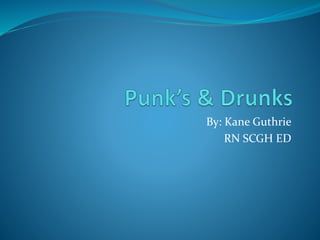
Punks & drunks
- 1. By: Kane Guthrie RN SCGH ED
- 2. Is there a problem in WA? Biggest issues in ED Alcohol Overdoses Mental Health Issues Heroin Drug Induced Psychosis Recreational Drug use occasionally
- 3. Overdoses Most Common Paracetamol Benzodiazepines Antidepressant Antipsychotics Antiepileptic Opioids Alcohol most common adjunct
- 4. Assessing the Intoxicated Patient! Obtain the following: 1. Pharmaceutical agent or toxin ingested: Two or more drugs are taken in 30% of cases. Alcohol is a common adjunct. 2. Quantity of agent ingested. 3. Time since ingestion. 4. Hx of toxic effects already experience by poison. 5. Specifics of events prior to arrival: a. Rapid deterioration in conscious level. b. Seizures.
- 5. Assessment Continued: 6. Corroborate the history in cooperative patient, but do not be mislead, as info supplied can be incomplete or deliberately false. 7. Rapidly assess airway patency, respiratory function, and conscious level. 8. Record pulse, BP, RR, Temp, and BSL, pupils, & attach cardiac monitor. 9. Hypoglycaemia and hyperthermia are common findings in collapsed patient with OD, & are commonly overlooked.
- 6. Clues to look out for: Signs of seizure activity, assess motor function of extremities. Dilated pupils: Tricyclics, amphetamines, antihistamines, anticholinergics agents. Pinpoint pupils: opiates, organophosphates. Nystagmus: alcohol, benzodiazepines, phenytoin. Hyperventilation: salcylates. Nasal bleeding: solvent abuse.
- 7. Medical Conditions Some medical conditions can make casualties present to us as they are intoxicated, be vigilant for: Head Injury Diabetes Epilepsy Infection Prescribed drug toxicity.
- 8. Why do people take recreational drugs! Euphoria Peer Pressure Social accepted? To fit in Experimentation Lack of understanding Regular use can lead to addiction!!
- 9. Alcohol Is the Bain of emergency departments Indicated in 30% of presentations to ED Pt’s difficult to assess and find underlying injuries when intoxicated (esp. Head Injury) Injured pts who are intoxicated have an increased mortality rate. Chronic use leads to organ damage
- 10. Alcohol Absorption Alcohol is rapidly absorbed from the small bowel (around 80%), and stomach (around 20%). Alcohol is water soluble, and little or no alcohol enters fatty tissue. Reaches brain within 5mins, blood concentration peak between 30 to 90 (Typically 45mins). Absorption will vary with: Beverage type Presence of food in stomach Individual factors: age, gender, size, drinking rate, experience.
- 11. Harms of Alcohol Abuse: Most drinkers (73%) generally consume alcohol in ways considered at low health risk (AIHW, 2002). Contributes to over 3000 deaths per year. 18% of injuries presenting to ED. 50% assaults. 30% of Car accidents 34% of drownings and falls. 44% of fire related injuries. Source: (CDHAC, 2001; CDHA, 2002;nhmrc, 2001;APF, 2001; Alcohol and other drugs: A Hand book for Health Professionals).
- 12. Drugs Types The Groups: Stimulants Depressants Hallucinogens
- 13. How they effect the body! Have there effect by how they affect the CNS Each drug have different effects on the body Hard to know what is actually in street drugs Tolerance Regular use
- 14. Stimulants Speed Ecstasy (Most Common) Cocaine Amphetamines (Meth, Crystal)
- 15. Amphetamines
- 16. Positive signs of Amphetamines
- 17. Positive signs of Amphetamines
- 18. Types of Amphetamines 1.Methamphetamines: Commonly know as “speed or whiz”. Speed varies in: Texture ( fine crystallised or coarse powder). Colour ( white to yellow, brown, orange or pink, Purity
- 19. Types of Amphetamines 2.Crystalmethamphetamine : Known as Ice, crystal meth. Has a crushed ice appearance. Usually smoked, but can be dissolved in water for injection, can be swallowed or snorted.
- 20. Cocaine Cocaine is a stimulant derived from the South American coca plant Cocaine is either snorted, smoked, intravenously administered. Cocaine use produces euphoria, mental stimulation, and generalised central nervous system stimulation. Ingestion of 1g or more is potentially lethal.
- 21. Ecstasy Ecstasy is generally the street name applied to MDMA. Used as a stimulant. Common at raves, night clubs Known on streets as soft drug, causes 3-5 deaths each year (WA) Hyperthermia, water intoxication
- 22. Stimulant Signs and Symptoms Increased BP Increased HR Increased Temp Increased RR Pupils dilated Alert, aroused, agitated, paranoid, Aggressive Headaches, Can Develop: MI, CVA ,Seizures, Psychosis
- 23. Stimulants Management DRABC Monitor Vital Signs Low stimuli environment May require security/police May need t/f to hospital
- 24. Depressants Alcohol Heroin (Opiates) GHB Toxicity
- 25. Depressant Signs & Symptoms Decreased Conscious state Decrease RR May have Low BP & HR Small Pupils
- 26. Depressant Management DRABC Conscious state can deteriorate quickly May require respiratory support Arrange transport to hospital ? Naloxone use in prehospital environment
- 27. Hallucinogens LSD (lysergic acid diethylamide) Magic Mushrooms Anticholinergics (datura, angles trumpet) Ketamine (dissociative) Marijuana
- 28. Hallucinogen Signs & Symptoms Bizarre thought disordered behaviour Visual or auditory hallucinations Anxiety Increased HR Impaired coordination Paranoid
- 29. Hallucinogens Management DRABC Low stimuli environment May require restraint and sedation Conscious state can deteriorate quickly Can develop fast heart rates
- 30. Some end up in ICU
- 31. Drink Spiking WA study Prospective study of 101 patients with suspected drink spiking People who thought there drink had been spiked encouraged to attend ED (SCGH,JHC) 97 alleged cases (88% female) 28% had illicit drugs on board Medium Blood Alcohol was .096 Result no detectable sedative found in urine or blood test
- 32. Difficult Behaviours Can result from D&A use or Mental Illness Violence & Assault common occurrence in the community every day Remain Open and positive Don’t stereotype or Judge Maintain your own safety Everyone has a story let them tell it.
- 33. Violence and Aggression Management: May require Restraint by police, Rapid sedation Low stimuli environment Patients generally remember everything that happens
- 34. WA Poisons Information Centre 13 11 26 Located next SCGH ED Excellent resource for finding out information Available 24/7
- 35. The End
